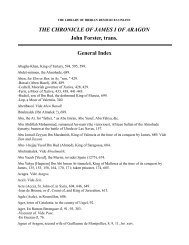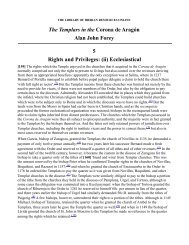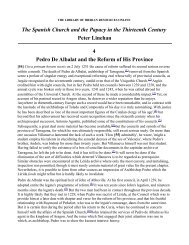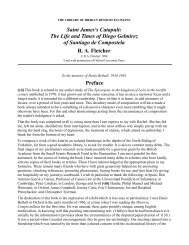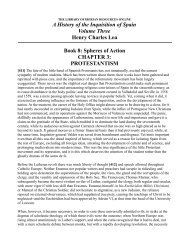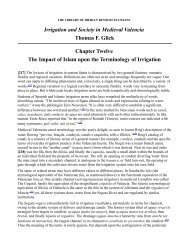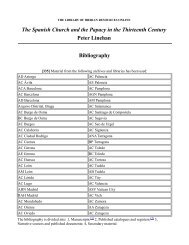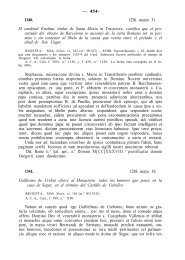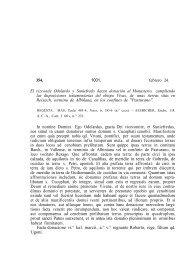Chapter 6 - The Library of Iberian Resources Online
Chapter 6 - The Library of Iberian Resources Online
Chapter 6 - The Library of Iberian Resources Online
You also want an ePaper? Increase the reach of your titles
YUMPU automatically turns print PDFs into web optimized ePapers that Google loves.
anticlericalism is implicit in their word for clergyman, farfare, a term suggesting thin skin or halfbaked.<br />
(21)<br />
<strong>The</strong> language <strong>of</strong> religion was useful to the underworld in a more serious sense also. For example, when<br />
the hero <strong>of</strong> one <strong>of</strong> their ballads was wounded, his friends gathered around him:<br />
Some promised him Masses,<br />
Others fingered their Rosaries;<br />
Others lit candles<br />
Others sang Psalms. (22)<br />
In another ballad, a contrite young ruffian entered town and asked to talk things over with another he<br />
had wronged. <strong>The</strong> second ruffian conducted himself with dignity and bravado and casually threw out<br />
his "benediction" to the younger man. (23) [127] Religion provided not only the words but the<br />
procedures <strong>of</strong> some underworld characters.<br />
A basic theological attitude is apparent in underworld words for God, man, and woman. Ballads <strong>of</strong>ten<br />
referred to a man as coyme, a word now used for gambling-house owner or keeper. Women in these<br />
ballads were coymas, usually meaning prostitutes. God was el coyme del alto, literally "the man from<br />
above." (24) <strong>The</strong> close similarity between the words for man, woman, and God suggests that these<br />
people sensed much less difference between God and themselves than conventionally religious people<br />
like the ancient Jews, who for a long time were forbidden to name God. Underworld people might have<br />
mocked the Church as intermediary because they felt more similarity with God and less need for an<br />
intermediary. <strong>The</strong>y knew the words and procedures <strong>of</strong> religion, and they broke their holy spell by using<br />
them for their own purposes. <strong>The</strong> Church wanted to bolster its authority as the only agency capable <strong>of</strong><br />
using the language <strong>of</strong> religion, but the underworld showed that anyone could use this language.<br />
THE CHURCH AS REFUGE<br />
Traditionally, the Church provided asylum for people whose lives were in danger, but after 1520 this<br />
role was limited. As more and more ruffians ran into churches to escape hotly pursuing sheriffs, the<br />
Church and secular authorities agreed that churches should not be allowed to become havens for<br />
unlawful thugs. <strong>The</strong> Count <strong>of</strong> Puñoenrostro took a hard line when he became head <strong>of</strong> the city<br />
government in 1597. He ordered his lawmen to enter churches and forcibly remove any fugitives. (25)<br />
Though churches were no longer to be used for asylum from secular authorities, they were still<br />
considered sanctified buildings, places that should provide sanctuary from nonauthorized violence. One<br />
<strong>of</strong> the most shocking incidents in seventeenth-century Seville, for example, involved a murder in a<br />
church, committed by the gang called the "Esquiveles." A fight over a woman [128] erupted between<br />
this gang and another man. Trying to escape, the man dashed into the Church <strong>of</strong> San Pedro and hid<br />
behind the priest. <strong>The</strong> gang killed him before the altar even though the priest tried to shield him with<br />
his chasuble. Leaving the dying man, a horrified priest, and the shocked congregation, the killers fled<br />
the city. <strong>The</strong> ecclesiastical chroniclers reported with some satisfaction that the killers soon died in other<br />
skirmishes, implying that Divine Justice had the last word. (26)<br />
Although people could look less to the Church as an asylum during this period, they looked to it more<br />
as a refuge from need. <strong>The</strong> population <strong>of</strong> Seville grew rapidly in the sixteenth century, but many <strong>of</strong> the<br />
people who came to the famous port seeking their fortunes found only poverty. Monks and priests<br />
distributed food to the hungry and helped many homeless people find shelter. <strong>The</strong> Archbishopric<br />
provided charity from its own wealth and also administered many charitable bequests made by wealthy<br />
individuals. In addition, the Church encouraged less wealthy people to provide charity. One<br />
ecclesiastical report described a system by which people wanting indulgences from the Church went to




